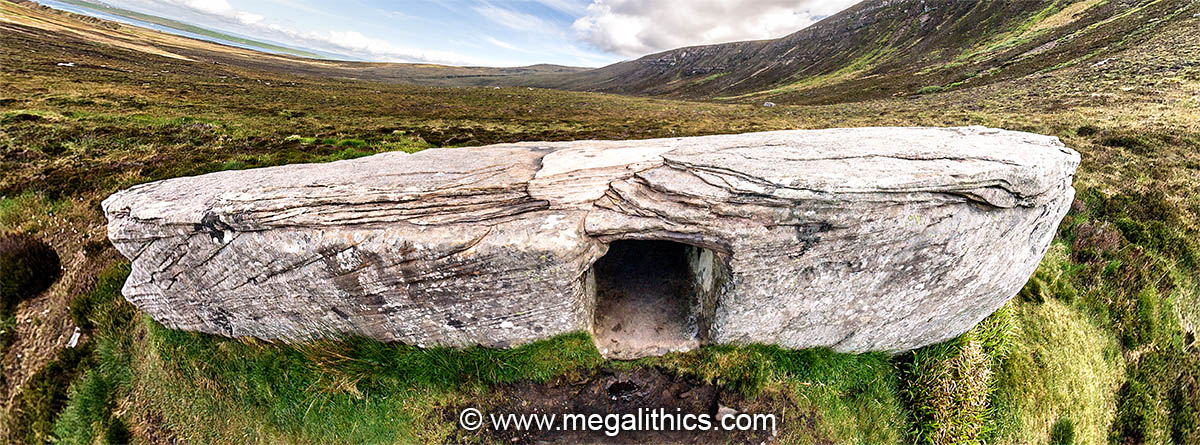 |
| HY 24333 00409 (GPS 25min) above doorway. | Stone 8.6m x 4.4m x 2m (Pub). |
| Visited June 2008 | Alt.79m OD (GPS.) |
 |
The Dwarfie Stane (ORK 13), is a rock-cut tomb, the only known example of this type of monument in the British Isles, it is also the only known prehistoric chambered tomb on Hoy. It is situated in the valley between the Dwarfie Hamars and Ward Hill, about 3km south of the ferry landing at Moness.
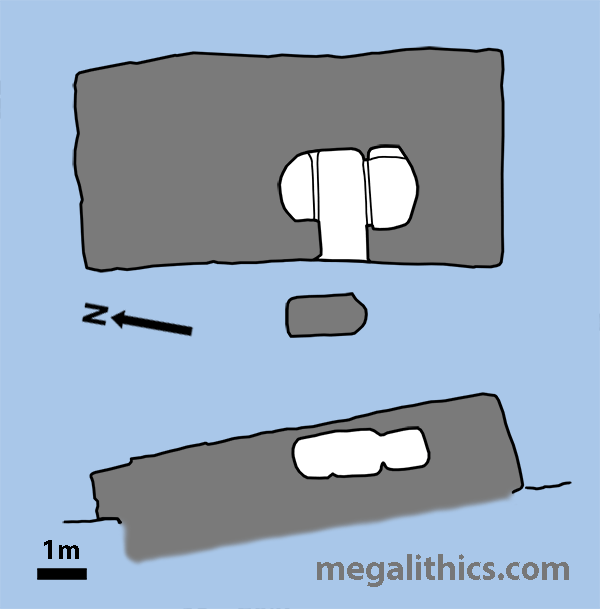
PUBLISHED ACCOUNTS
In contrast to the paucity of publications dealing with some other prominent Orkney monuments, the wide-spread fame of the Dwarfie Stane is reflected in the sheer mass of literature dealing with it. Many point to Scott's inclusion of the Stane in one of his popular novels as the reason (see below), but there is still a large volume of publications dated before this occurred. Whatever the reason, here is our selection from the cornucopia.
The first mention we can find of the The Dwarfie Stane is by "Jo Ben" (1) in his "Descriptions of Orkney". There is a problem with this source, the original manuscript was in Latin and is now lost, modern versions are based on three Latin transcripts of the original which differ from each other considerably. The original was dated 1529 and, if genuine, is the earliest written Scottish topology. For Hoy, the account tells of a giant and his pregnant wife who lived in the Stane; a second giant, who disliked the first, made a stone plug and inserted it into the Stane trapping the couple. The trapped giant then gnawed a hole in the roof "made a gutter" and escaped.
The important information contained in the piece is "It has the mouth shut forcibly by a stone", i.e. the closing stone was still in place at the time of Jo Ben's account, and the gnawed "gutter" also shows that the robber hole was too.
The Stane is mentioned and illustrated in the Rev. Wallace's manuscript of 1693 (2), he also confirms the presence of the robber hole at that time, "in the middle a Hearth for a fire, with a round hole cut out above for the chimney." The closing stone had been removed by this time as he describes the entry hole as having "a stone proportionable standing before it for the door."
Brand describes the Dwarfie Stane in 1701(3) including the robber hole, "a large hole above about the bignefs of the entry through which a person may come up to the top of the ftone, and might ferve, for a vent to the fmoke." He also describes the closing stone as standing 2 foot from the opening, but this section seems to have been inaccurately copied from Wallace's account, as apart from the 2 foot distance, the paragraph is nearly verbatim.
Pococke published a (very inexact) illustration of the Stane in his "Tours" of 1760 (4), showing a fantasy arched entrance and columned interior. He thought that the Stane was "the retired Cell of some melancholick Hermite".
Principal Gordon of the Scots College in Paris, writes of his visit to the Stane in 1792 (5), "Near to the door of this cell is a ftone four feet high, and two feet and an half broad". This obviously refers to the closing stone, and from his description, it was standing upright at this time.
Sir Walter Scott incorporated the Stane into his novel "The Pirate" (6), giving a really detailed description, "the Dwarfie Stone, as it is called, a relic of antiquity, which strangers look on with curiosity, and the natives with awe. It is a huge fragment of rock, which lies in a broken and rude valley, full of stones and precipices, in the recesses of the Ward-hill of Hoy. The inside of the rock has two couches, hewn by no earthly hand, and having a small passage between them. The doorway is now open to the weather; but beside it lies a large stone, which, adapted to grooves still visible in the entrance, once had served to open and to close this extraordinary dwelling, which Trolld, a dwarf famous in the northern Sagas, is said to have framed for his own favourite residence."
Perhaps Scott's popularisation of the Stane had negative results, as John Tudor (7) remarked in 1883 that "The hole on top... is every year being made larger by the curiosity collecting cads chipping off portions to carry away." He is also a little puzzled by the legends that the Stane was home to a giant and his wife, "If so, they must have been Pictish, or Pechtish giants, as there is not room in either apartment for any large-sized mortal."
Calder publishes an excellent description of the monument with very detailed diagrams in 1936 (8), but most importantly, he correctly identifies the nature of the monument for the first time, claiming "that the Dwarfie Stane is the first and only example in the British Isles of a completely rock-cut tomb of the late Neolithic or Early Bronze Age." He also draws comparisons of the layout of the cells with those at other Orkney tombs such as Maes Howe and Calf of Eday.
Henshall includes The Dwarfie Stane in her magnum opus of 1963 (9) publishing a plan and description. Her account was later expanded in her most excellent work on the Orkney chambered cairns (10) in 1989, although strictly speaking, the Stane is not a cairn.
The Dwarfie Stane is, of course, mentioned in a plethora of general works and will certainly feature in any comprehensive guide to prehistoric Scotland or Orkney (11).
DESCRIPTION
The Dwarfie Stane stands in a valley between the Ward Hill, the highest point in the Orkney Isles, and the cliffs and scree of the Dwarfie Hamars, the land is boggy moorland. The Stane is one huge rectangular slab of old red sandstone which appears to lie slightly canted, either the slab is asymmetrical or the northern end is buried to a depth lower than the south. The stone is thought to have been moved to its present location via glaciation. It measures approximately 8.6m x 4.2m x 2m, and if it is a uniform slab, it will weigh over 150 tonnes.
The cells and entrance have all been carved out of the rock without the aid of metal tools, antler picks, or more probably, hard stone points would have been used. The tool marks are still visible inside the Stane, particularly in the southern cell. The entrance is situated about 3m from the S end, the builders probably chose this area as there would enough rock to accommodate the height of the cells. The entrance is 0.75m high and 0.85m wide, the lip is about 0.15m above current ground level. The edges of the opening are rounded an much damaged by ancient attempts to remove the sealing stone, the upper edge, in particular, has been cut back considerably. The entrance opens into a "passage" about 0.9m wide and 2.3m long, the sealing stone, if fully inserted flush with the outer face would leave a 0.7m gap at the back. The first 0.3m of the space is narrowed in height by a bevel above the doorway and, although the walls are flush throughout the central space, there appears to be a "frame" around the opening when viewed from the interior.
The floor of the interior is near level, which shows that the Stane has not moved from its current canted situation since the chamber was cut. There are two cells opening to each side of the central space, north and south.
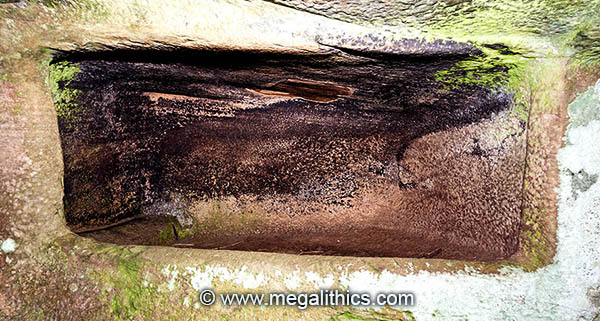
The entry to the southern cell is 1.25m wide and 0.52m high, this is slightly smaller in height and width than the interior, forming a lip all the way round, almost like a frame. The roof inside the cell is slightly lower than central space and the floor considerably higher. The cell reminded us strongly of a sleeping berth onboard a boat. The interior walls are all slightly concave and every corner is radiused, dimensions inside are 1.5 x 0.9 x0.8m. At the east end of the cell there is a raised ledge 0.2m wide and 0.08m high running the whole width of the cell and fusing seamlessly with the side walls. This ledge is rounded and has two slight depressions worked in it, it strongly resembles a pillow with indentations for two heads, further reinforcing our sailing berth similarity. We noticed that a large area of stone on the west end of the cell roof had delaminated, the stone exposed looking fresh, and there were a few flat fragments in the cell that may have come from this.
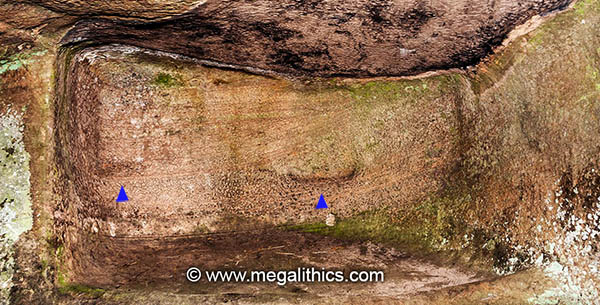
The northern cell opens off the central space with very little demarcation, there is a low kerb about 0.05m high across the opening and there is a slight lip where the cell wall meets the entrance "passage" at the west. The kerb in the floor was probably much more prominent originally as until relatively recently people could access the interior through the hole in roof, as the kerb is directly below this, there must have been considerable wear from the passage of feet there. Any division on the roof was destroyed by the robber hole there. The interior of the cell is more rounded than the southern and internal dimensions (lwh) are1.25 x 0.6 x 0.7m. The robber hole was patched in the second half of the twentieth century with a cement repair which is very obvious.
We noticed two recesses worked into the northern wall of the north cell (arrowed in photo above), they both have definite ledges at their bases and seem to be rectangular, the right one measuring about 28 x 36cm. The surface of these "niches" are covered by the peck marks left by the tooling used to fashion the chamber, so they are very likely to be original features. These niches are not mentioned in any publications we can find, which is odd as they are so apparent. For more photos and coverage on these recesses see the Rock art page.
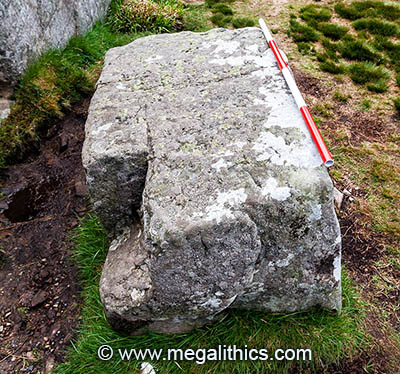
Just outside the entrance is a large stone 1.6 x 0.8 x 0.65m (lwh) weighing about 1.5 tonne, this stone was used to seal the entrance. The southern end of the stone is markedly convex where stone was chiselled away by attempts to gain access to the tomb interior when the stone was in place. Presumably the same process that chewed away the edges of the entrance itself. Jo Ben reports the stone in place in 1529, it does not appear in Pococke's illustration at all, Gordon describes the stone as out and upright in 1792 and finally Scott describes it lying (presumably where it lies today) in 1822. Jo Ben's account means that the stone was left in place after the robber hole gave access to the interior. The hole is in the roof of the northern cell, but there would have been a 0.7m gap behind the plug that would also allow access to the southern cell, so there was no reason to remove it for the purposes of tomb robbing.
About 30m ESE of the Stane lies a similar sized stone that bears the marks of shaping by chiselling, perhaps a failed candidate for the closing plug.
The Stane seems to have be a magnet for graffiti artists of old, Henshall reports the oldest as "H. Ross 1735" and even the Stonemason Hugh Miller admits to defacing it is his book "The Cruise of the Betsey "with my geological chisel and hammer I did, to beguile the time, what I very rarely do,—added my name to the others". Luckily age and the abundant lichen growth has erased much of the graffiti, or at least made it less noticeable. Perhaps the most notable (and bonkers!) defacer was William Mouncey, see our rock art page for details.
MONUMENT CLASSIFICATION
As the only known rock-cut tomb in the British Isles, there are no similar or congruent monuments to compare it with, indeed, Calder had to resort to examples in Mediterranean countries for his comparisons. There are no finds, the cells were cleared out long ago, and there is no rock art apart from modern graffiti. There is no objective dating evidence of any kind for the Stane. It is the only known chambered tomb on Hoy, there is no associated local tradition on the island. There is no direct evidence that the monument was a tomb, or was used for any mortuary purposes.
Going by interpretation of the form of the monument alone, it is thought that the Stane is a Neolithic burial chamber and is given a date window of 3500 - 2500 cal BC by analogy with other Orkney tombs. All of this is speculation at best.
About the only assumption that can be made with any objective basis is that the cell arrangement at The Dwarfie Stane resembles that of Orkney-Cromarty chambered cairns with Bookan type chambers.
A unique, puzzling and intriguing monument.
VISITING
Firstly there is the not inconsiderable obstacle of getting to Hoy in the first place. There is a short 3km drive from the ferry landing at Moness and there is a good parking area for the Stane. The Stane is about 400m from the car park over very boggy moorland, but there was an excellent boardwalk there during our visit so your feet will be dry. There is enough light coming through the doorway on bright days to examine interior, but bring a torch if you want to go graffiti spotting inside. There is no shelter and there are NO facilities of any kind nearby.
Given the car access and the smooth level boardwalk, the Stane should be accessible for even moderately disabled folk with assistance.
1.
"Joannem Ben", "Descriptio
Insularum Orchadiarum. Anno 1529", ms, 1529.
2.
Wallace, J., "A Description
of the Isles of Orkney", ms, p.19-20 1684.
3.
Brand, J.,
"A Brief Description of Orkney, Zetland, Pighland-Firth
and Caithness",
p.196-7, 1701,
Edinburgh.
4.
Pococke, R.,
"Tours in Scotland 1747,1750,1760", p.135-6,
Scottish History Society, 1887 Edinburgh.
5.
Gordon, ?., Archaeologia Scotica, 1, p.265-6, 1792.
6.
Scott, W., "The Pirate" p. 299, 1822, Edinburgh.
7.
Tudor, J. W., "The Orkneys and Shetland; their past and present state" p.323-4,
1883, London.
8.
Calder, C.S.T., Proceedings of the Society of Antiquaries of
Scotland, 70, p.217-29,
1936.
9.
Henshall, A. S.,
The Chambered Cairns of Scotland,
p.196-7, Edinburgh University Press, 1963,
Edinburgh.
10.
Davidson, J. L. and Henshall, A. S., The Chambered
Cairns of Orkney, p.114-5,
Edinburgh University Press, 1989, Edinburgh.
11.
Childe, V.G. and Simpson, W.D.,
Illustrated Guide to Ancient Monuments in the
Ownership or Guardianship of The Ministry of Works,
5th ed, vi, p.18 & 113, Edinburgh 1967.